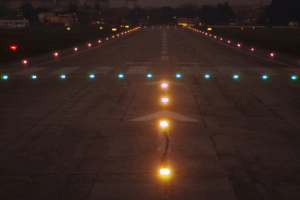Runway lighting technology has undergone significant advancements over the last 100 years. Its evolution from simple incandescent lights to sophisticated systems integrating LEDs and intelligent control mechanisms has been pivotal in enhancing aviation safety, efficiency, and operational precision, especially during low visibility conditions, nighttime operations, or adverse weather situations.
These ongoing leaps in innovation have resulted from a continuous quest for improved safety, energy efficiency, and operational effectiveness within the aviation industry.
Let’s explore the significant milestones and developments in airport runway lighting technology, starting in the early 1900s.
The Early Years: Incandescent Lights
Runway lighting systems in their infancy used incandescent bulbs. These early innovations provided a consistent light output but also had several limitations; they were not energy-efficient, required frequent maintenance, and had a short lifespan. They were also unreliable during adverse weather due to their luminous intensity being impacted by temperature fluctuations and heavy precipitation.
In the 1940s, airport runway lighting safety was significantly improved by introducing runway edge lights. These lights were placed along the edges of runways, offering pilots a visual reference point for runway orientation. Runway edge lights vastly improved visibility during nighttime and adverse weather conditions, enhancing overall safety.
The 1960s: New Leaps In Airport Lighting Technology
The 1960s marked the transition from incandescent bulbs to quartz halogen runway lamps. These lights were significantly brighter, improving visibility and safety for pilots during landing and takeoff. However, they still required frequent maintenance and consumed significant amounts of power.
In the late 1960s and early 1970s, in-pavement centerline lighting systems were introduced. These systems embedded light fixtures directly into the runway, marking the centerline. This innovation further improved runway visibility and helped pilots maintain alignment during takeoff and landing.
LEDs: A Revolution In Airport Runway Lighting
The most significant leap in airport runway lighting came with the widespread adoption of Light Emitting Diode (LED) technology in the early 2000s. They have since become the industry standard in airports all over the world.
LED lights brought a paradigm shift in airport illumination due to their numerous advantages over traditional incandescent and halogen bulbs. These advantages included consuming significantly less energy, longer lifespans, and serving as a more consistent, durable, and reliable light source.
Innovative LED technology also allowed for precise color rendering, enhancing the distinction between different types of runway lights, such as threshold, edge, and centerline. They additionally facilitated the development of customizable lighting systems, enabling airports to implement innovative configurations to enhance pilots’ visual cues. For instance, pulsating lights or changing colors can signal specific conditions or warnings to pilots, improving their situational awareness and safety during critical phases of flight.
Precision Approach Path Indicator (PAPI) Systems
In addition to runway lighting and the integration of LED technology, the development of Precision Approach Path Indicator (PAPI) systems played a crucial role in aviation safety. PAPI systems use a combination of red and white lights to indicate to pilots if they are on the correct glide path during approach. These systems have been widely adopted to improve landing precision, reduce the risk of runway overruns or undershoots, and minimize delays due to poor visibility.
PAPIs also help reduce fuel consumption and emissions associated with aborted landings and additional fuel-burning loop-arounds, making them an environmentally responsible choice for airports with sustainability objectives.
Runway Status Lights (RWSL)
Another recent development in airstrip lighting technology is the implementation of Runway Status Lights (RWSL) systems. RWSL systems use LED lights embedded in the pavement to provide immediate visual cues to pilots about the status of a runway.
Red lights indicate that a runway is occupied or unsafe for landing, while green lights signal that it is clear for use. These systems significantly reduce the risk of runway incursions.
Smart Solutions For Runway Lighting
The integration of technology and automation in airport runway lighting has brought about intelligent lighting solutions that utilize sensors, cameras, and computer systems to improve runway safety and efficiency.
For example, airport lighting control and monitoring systems (ALCMS) are designed to detect changing weather conditions and with the help of ATC adjust the intensity and color of lights to guide aircraft movement. They can also switch lights on or off as needed, depending on runway traffic levels.
Read More: Illuminating Sustainability: How Airport Lighting Technology Meets Sustainability Objectives
What’s Coming In Airport Lighting Technology?
When it comes to airport lighting technology, the sky is truly the limit. Advancements in wireless communication, Internet of Things (IoT), and artificial intelligence (AI) are expected to revolutionize runway lighting further. Smart systems may also be optimized to enable predictive maintenance, self-diagnosis, and proactive adjustments based on predictive weather data, ultimately enhancing safety and operational reliability.
As new technology is introduced to aviation, trust Airport Lighting Company to be there first.
Call Airport Lighting Company For The Latest In Airport Lighting Technology
The Airport Lighting Company team is standing by to answer your questions about how our tech-based products can help improve the safety, reliability, and efficiency of your runways. Call 315-682-6460 for fast, friendly service you can count on.





